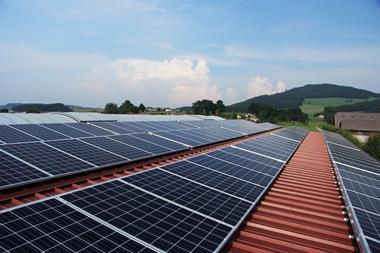Creating the built environment is a complicated business. Quite apart from all the different professionals involved in designing and producing the actual building envelope, there is the financial community that provides the funding and expects to make a return for their investors and savers; the property investors/developers who want to make a profit from the rental income and capital growth; and, of course, the occupiers without whom there wouldn’t be a great deal of point in producing the buildings in the first place.
Such complexity does not help when it comes to implementing policies aimed at improving the green credentials of buildings and in particular reducing energy consumption and carbon emissions. What tends to happen is that each party blames the next one in the food chain, creating what the environmental campaigner Jonathan Porritt calls the ‘circle of blame’.
The constructors and other professionals say they can build sustainable, low energy buildings but the property developers who are their customers don’t want to pay for them; the property developers say it is their investors and funders who don’t want the extra cost of building green buildings; and the funders blame the occupiers who they say don’t ask for green buildings and are not prepared to pay any more to occupy them. And so it goes on!
So how can the property owners and managers break into this vicious circle and turn it into a virtuous one?
The first step is to measure and understand the true environmental cost of our existing buildings. If we take energy consumption - and therefore carbon emissions - as probably the most currently significant environmental cost, it is imperative that building owners, investors and occupiers understand just how much energy is consumed, by whom and in what manner.
This is not as easy as it sounds. Indeed one UK fund manager says it has taken him over five years to get to grips with the true energy consumption of his portfolio of properties.
But it is something the built environment professionals are going to have to get to grips with if they are to be in a position to implement the EU’s Energy Performance of Buildings Directive which will require an Energy Performance Certificate whenever a building or part of a building is let or sold.
The second step is to work out just what can be done to reduce the energy requirements of a building and its occupiers. There are many measures that can be implemented to enhance the energy efficiency of the building envelope either at the building stage or, for existing buildings, through maintenance and management processes.
Once those have been introduced, and the energy demands of the building reduced to the minimum possible, there is then the possibility of improving the green nature of the energy supply through, where feasible, on-site generation of renewable energy - or if that is not cost effective through signing up to green energy supplies at either the local or regional level.
The third step is to engage with occupiers since buildings with the best green credentials can be ruined by a profligate occupier who has no regard for energy efficiency. This may, however, require a novel approach to traditional landlord and tenant relationships where the tenant is king in his ‘demise’ and can, in theory, do pretty much as he likes. Will he in future take kindly to a landlord seeking data about the energy used in his operations and then interfering in the day-to-day management in order to get find ways of reducing energy consumption?
Hopefully, enlightened occupiers will indeed see that the green building challenge is one that needs to be tackled jointly by landlord and tenant. But for those that don’t, we may need a redefining of the whole landlord and tenant relationship.
The fourth measure is to try to produce some straightforward calculations to show just how much improved energy performance is worth.
This is not an easy one since there will almost certainly need to be a trade-off between increased capital cost to build or renovate a building to a high environmental standard and the extent that this can be passed on to the tenant in the form of higher up-front rent but lower running costs.
And will tenants on relatively short leases be interested in annual savings on their energy bills when they might not be in the building long enough to benefit from them? The answer to this question will surely be ‘yes’ as occupiers become more interested in taking those buildings with good environmental credentials. And that in itself will help reinforce the value argument for producing better performing buildings.
The fifth and last of my areas for action - and I say this hesitantly as one who has spent the last five years generally trying to fend off government interference - is to put pressure on governments to provide the necessary framework for a coherent approach to energy efficiency. At the moment there is a lot of gesture politics about, with political leaders trying to outdo each other in showing their green credentials.
The property industry is not interested in which UK prime minister is the first to put a wind turbine on the roof of Number 10 Downing Street. What we are interested in is sensible change to the building control regime to ensure consistency across the country.
Standardised data about what measures produce the best results is essential. And a few tax incentives would help as well. What about reduced stamp duty for those buildings that meet the highest standards of energy efficiency - or lower local taxes for those businesses that operate in energy efficient premises?
In the UK, the house builders have taken the bold step of entering into a commitment with the government to produce all new homes to a zero carbon standard by 2016. This has had the effect of throwing down the gauntlet to the commercial property industry. Commercial property is, however, a lot more complicated than the residential industry. Unlike the ranks of standardised houses, every commercial building is, in effect, a one-off with highly individual performance and use characteristics. So the challenge for us is going to be all the greater.
But the industry is undoubtedly up to it and has committed to working together through an alliance of key players - the same one that won us UK REITs - to pick up the gauntlet.
A systematic addressing of the various steps I have outlined above by both industry and government will allow us to show that we are a modern and forward thinking industry that has both the ability and the will to produce and manage a built environment that will not cost the earth.
The issues raised in this articled will be debated at a plenary session of the MIPIM Conference on Thursday 15 March between 3-4pm in the Esterel Auditorium of the Palais des Festivals. Speakers will include representatives from the UK government, the UK construction and property industries and the Property Council of Australia.
Liz Peace is chief executive of the British Property Federation and chairman of the managing committee of the European Property Federation












No comments yet